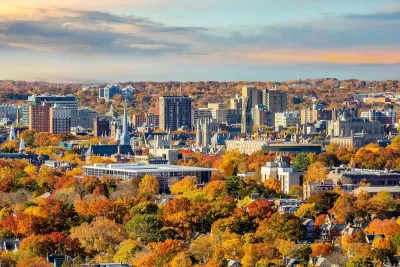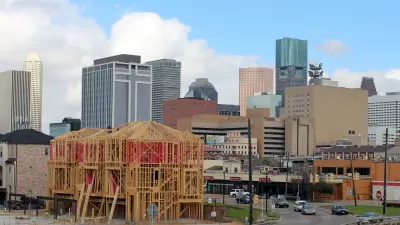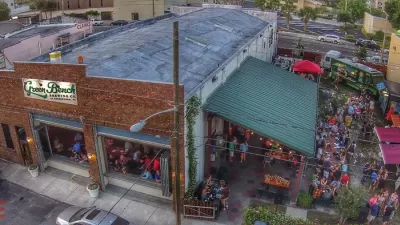Seeking recovery from decades of failed urban renewal projects, New Haven rings in the new year by continuing a series of small-scale urban planning initiatives to reinvent its municipal spaces.

As the cultural capital of Connecticut, New Haven begins the new year by pursuing several small-scale urban planning initiatives to reinvigorate its areas lost to urban renewal.
Heavily impacted by the overambitious urbanization of American cities in the 1950s-1960s, New Haven is still recuperating from the effects of the interstate highway system, including the demolition of local neighbourhoods and uncompleted roadway construction.
According to Jared Brey, a senior reporter at Governing, “there are now efforts underway all around New Haven to reshape its character. It’s plain to city planners today that tearing down dense housing in downtowns to make room for highways was a bad idea. Incremental, small-scale development is what gave the densest parts of New Haven and other cities their identity. Cities in general are now clamoring for more housing and trying to mitigate the impacts of air pollution and greenhouse gas emissions caused by highways.”
In response to previous urban renewal efforts, the city continues implementing its two-decade project “Downtown Crossing,” which aims to reinvent the uncompleted Route 34 Oak Street connector highway. This small-scale reinvention entails designing pedestrian crossings over top of the highway, to connect previously destroyed neighbourhoods with the downtown area.
Brey highlights the destructive history of the Route 34 Oak Street connector highway: “countless cities were reconfigured by the interstate highway and urban renewal programs of the mid-20th century, but few were altered as profoundly as New Haven. The center of the city was bulldozed to build portions of I-95, I-91 and the Oak Street Connector, the stretch of highway that was never finished. Blocks of tightly knit homes and businesses — slums in the parlance of the day — were cleared for new housing, roads and parking ... the Oak Street project alone displaced more than 880 families and 350 businesses.”
Despite Downtown Crossing's urban planning initiatives to repair the wreckage of Route 34 Oak Street Connector Highway, its main objective concentrates on rejuvenating the true character of the city. This entails the incorporation of new bicycle lanes, protected spaces for pedestrians, and native green infrastructure, which is meant to provide a sense of united locality and community fellowship.
Justin Elicker, the Mayor of New Haven, sheds light on the project: “in the past, there was so much focus on using cars to facilitate people living in a single-family house in the suburbs, and over time, people have realized that doesn’t necessarily provide the best opportunities for someone to be a whole person ... this project is one example of creating spaces where people will choose to be, that make people better people by facilitating interactions.”
However, according to Alan Plattus, the founding director of “Yale Urban Design Workshop”, rectifying the aftermath of failed urban renewal projects may further contribute to the issue: “one of my classic examples of how the damage never totally goes away is that the dimensions of the original Route 34 have been reproduced in the footprints of the so-called repair projects.”
Although met with constructive criticism, New Haven’s Downtown Crossing is committed to revitalizing its damaged areas and local neighbourhoods. Only time will tell how effective such urban planning initiatives will be, and whether present restoration efforts can outweigh the cost of unfinished urban renewal.

Maui's Vacation Rental Debate Turns Ugly
Verbal attacks, misinformation campaigns and fistfights plague a high-stakes debate to convert thousands of vacation rentals into long-term housing.

Planetizen Federal Action Tracker
A weekly monitor of how Trump’s orders and actions are impacting planners and planning in America.

Chicago’s Ghost Rails
Just beneath the surface of the modern city lie the remnants of its expansive early 20th-century streetcar system.

Bend, Oregon Zoning Reforms Prioritize Small-Scale Housing
The city altered its zoning code to allow multi-family housing and eliminated parking mandates citywide.

Amtrak Cutting Jobs, Funding to High-Speed Rail
The agency plans to cut 10 percent of its workforce and has confirmed it will not fund new high-speed rail projects.

LA Denies Basic Services to Unhoused Residents
The city has repeatedly failed to respond to requests for trash pickup at encampment sites, and eliminated a program that provided mobile showers and toilets.
Urban Design for Planners 1: Software Tools
This six-course series explores essential urban design concepts using open source software and equips planners with the tools they need to participate fully in the urban design process.
Planning for Universal Design
Learn the tools for implementing Universal Design in planning regulations.
planning NEXT
Appalachian Highlands Housing Partners
Mpact (founded as Rail~Volution)
City of Camden Redevelopment Agency
City of Astoria
City of Portland
City of Laramie




























